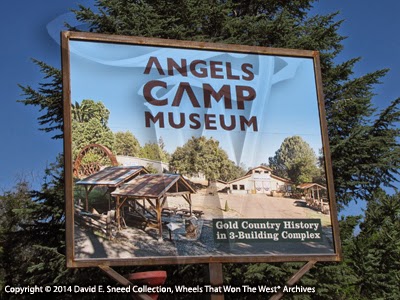Some of the earliest examples of promotional literature in the Wheels That Won The West® Archives date to the 1860s. Among those pieces are a pair of hardback catalogs distributed during the Civil War era. They were originally published by a pair of well-known wagon and carriage makers in the eastern United States. As rare as these sales books are, pre-1870 materials promoting legendary western wagon brands are even harder to come by. It's one of the reasons we feel fortunate to have an 1869 flyer for the Bain Wagon Company in our collection.
Established in 1852 by Ed Bain, the firm took over the factory in Kenosha, Wisconsin that had previously been used by Henry Mitchell and the Mitchell Wagon Company. Launching from a strong foundation that Mitchell had laid in Kenosha, Bain made the most of a solid distribution system and quickly became a popular vehicle in the West. Early product offerings went beyond farm, freight, ranch, and spring wagons and also included carriages and buggies. According to research shared in Mark Gardner's book, "Wagons for the Santa Fe Trade," in the 1880's, Bain was considered to be one of the top 3 wagon brands in the West. The other two were Peter Schuttler in Chicago and A. A. Cooper from Dubuque, Iowa (see our November 6, 2013 blog).
Earlier this year, I had the privilege of traveling through several remote areas of California. One of them was the small and welcoming city of Angels Camp. A legendary mining town with a history dating to 1848, the area is also well-known as the source of one of Mark Twain's writings, "The Celebrated Jumping Frog of Calaveras County." Beyond those accolades, the town is also home to one of the best collections of original western vehicles I've ever had the privilege of reviewing. Sitting on a hill just above many of the historic town buildings is the Angels Camp Museum. From the outside, it is well-kept but somewhat unassuming in nature. So, a word of advice... if you find yourself in the area, do not judge this book by its cover. Like a pearl of great price, most of what the facility holds is not visible from the outside. Once inside, though, the treasures are almost innumerable. I was particularly amazed at both the depth and the quality of the vehicle collection. Original stage coaches, freight wagons, logging wagons, business vehicles, and so much more are housed within the multi-building complex.
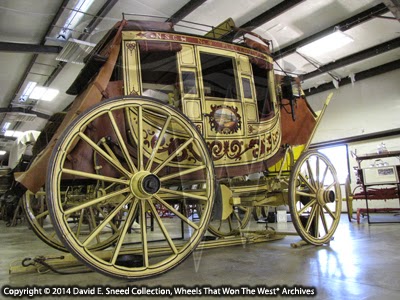
This Downing & Sons Concord coach is a 9-passenger stage believed to date to between 1848 and 1858.
I spent hours photographing and analyzing the vehicles in the Carriage & Wagon building. I took so much time, that I almost overlooked the Mining & Ranching building. It too holds its share of wooden wheels. One of the best is a yellow-geared Bain Rack Bed. Wow! Beyond the brand itself, perhaps its most significant feature is its remarkable condition. Now, don't get me wrong. It isn't perfect. But, considering that these pieces were built for hard use in rugged terrain, the vast majority will not be found in this kind of shape. With limited wear to the overall wagon, there is a fair amount of original paint still present on the gear along with some paint on the box. Even the round edge steel tires appeared to have plenty of miles still left on them.
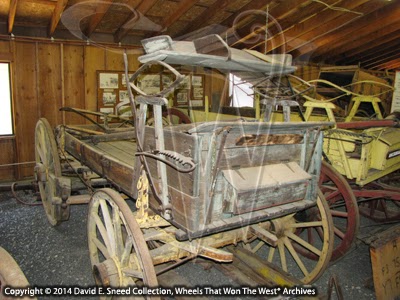
An extraordinary example of a surviving western rack bed, this wagon was built in Kenosha, Wisconsin by the legendary Bain Wagon Company.
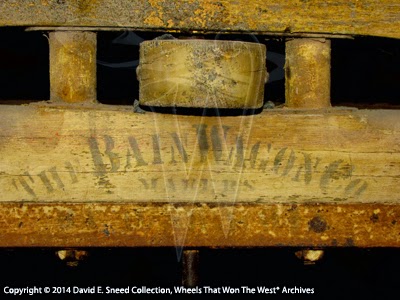
Surviving in a rare, "last-used" condition the maker name stenciling on this wagon is still quite legible on the front and rear axles.
At this point, some may be saying, "What the devil is a rack bed?" Good question. A rack bed is a type of mid-sized freight wagon often used in the West but could also have been used in regions throughout the U.S. The box or bed can be the same length (10' 6") as most surviving farm wagons but it often measures another foot or more in length. It typically has a thicker floor and the box is equipped with a lower sill or sideboard that is shorter (perhaps as small as only 5"- 8" in height). The upper sideboard will be considerably taller than the lower and, because it's usually removable, it will likely not run the full length of the bed since the forward section provides a fixed support for the seat risers. Elsewhere, vertical wooden stakes are attached to the upper sideboard and insert into heavy metal clips on the lower sideboard. The spring seat is placed on a seat riser mounted to the outside of the box.
This particular Bain is equipped with wheel heights of 52"/44" and a tire width of 2 ¼". All four wheels include both tire and spoke rivets for added strength and durability. The box width is 44" and the length is 11' 9". One notable trait on the metalwork - the stake pockets on the bed's lower sideboard are a heavy cast design with B. W. C. lettering.
Our thanks go out to the wonderful staff at Angel's Camp Museum. They're curators of some of America's most amazing transportation history and deserve to be recognized for their commitment to preserving that western heritage.
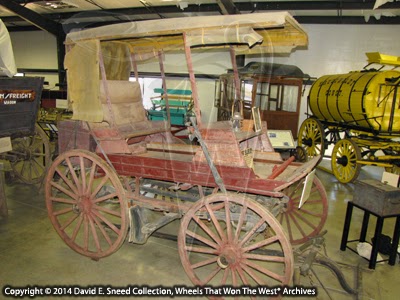
This light western mail stage saw duty in Angels Camp and the surrounding areas.
